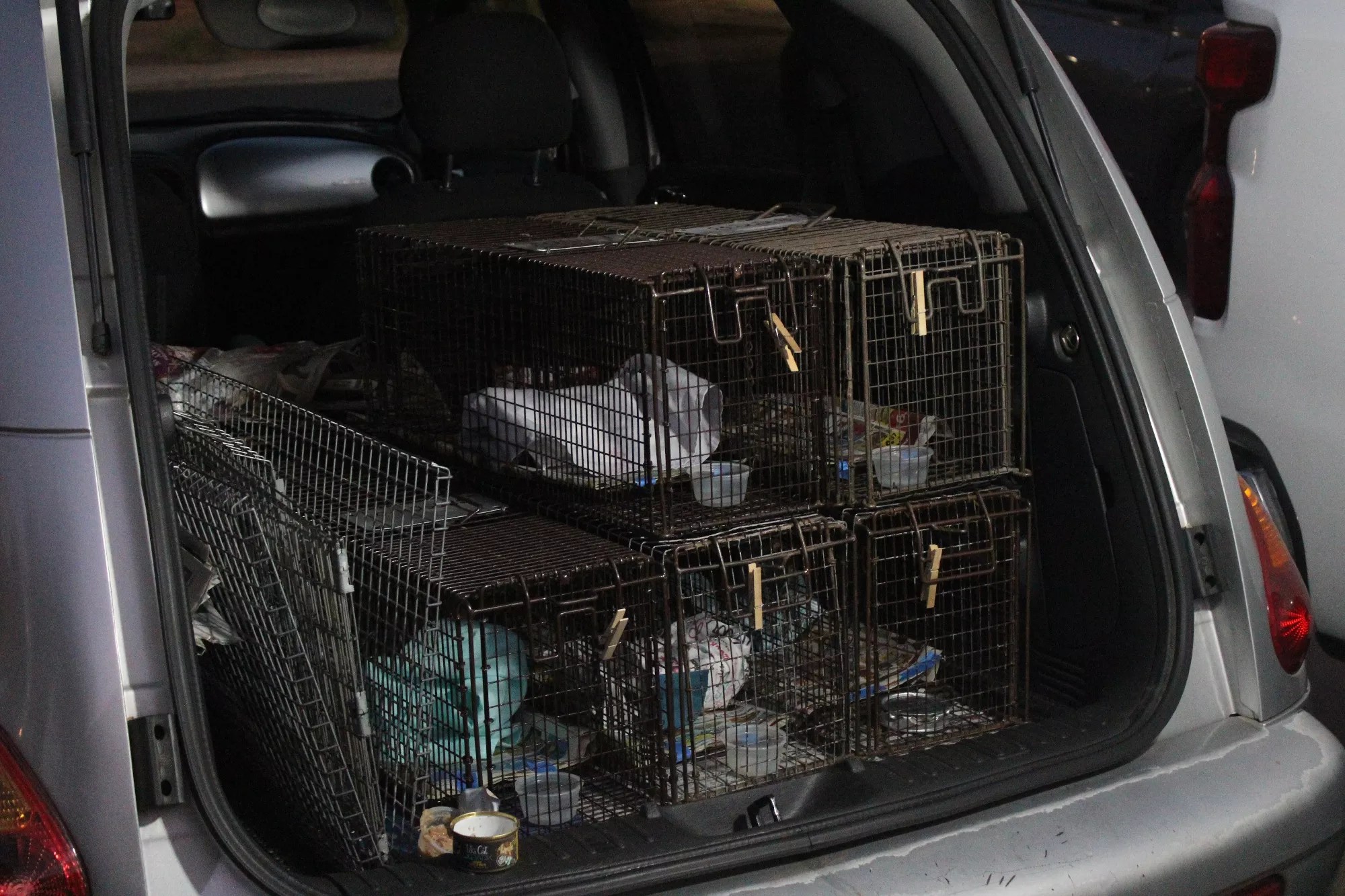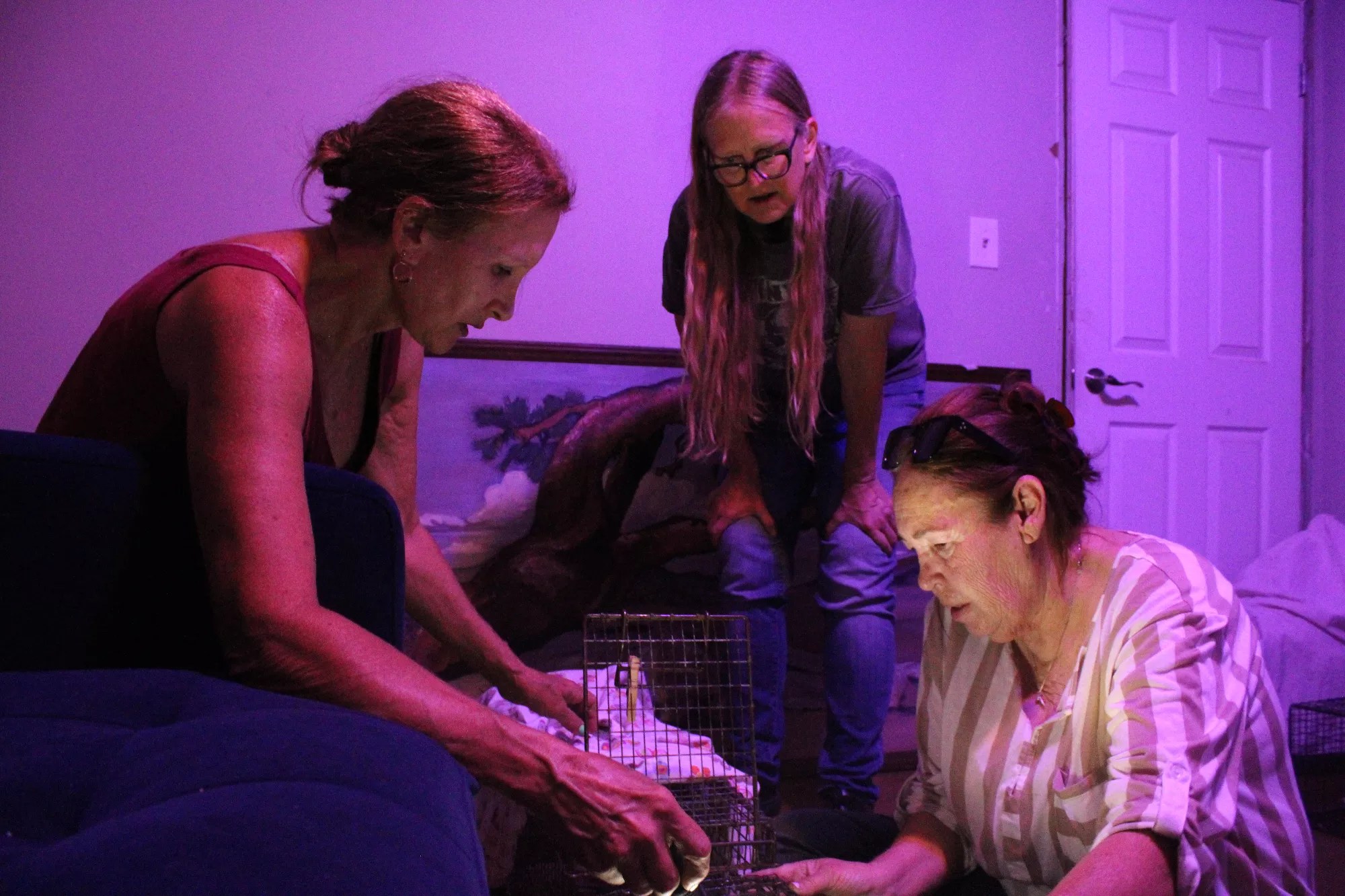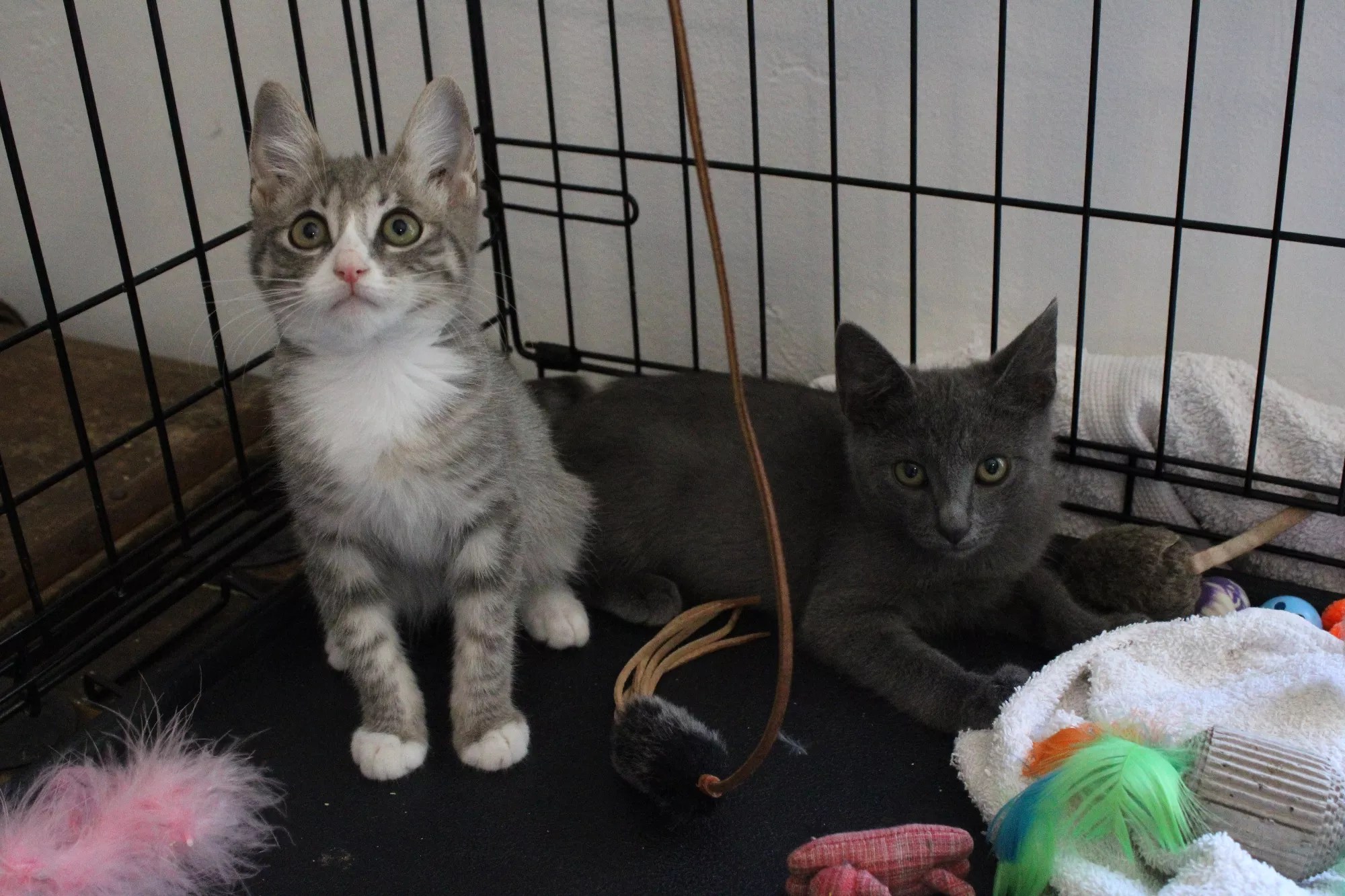
Illustration by Chas Coffman

Audio By Carbonatix
The sun was slowly setting one September evening in the Green Gables neighborhood of central Phoenix as Wendy Morris popped the trunk of her silver PT Cruiser. One by one, she unloaded seven or eight long metal animal traps, the bottom of each lined with newspaper. Over the next few hours, Morris hoped to fill those traps with cats.
This is a near-nightly ritual for Morris. Clad in gray cargo shorts, a maroon cropped tank top and Birkenstock sandals, she ventures out each evening, setting traps and waiting for stray cats to take the bait. The Valley’s urban landscape offers plenty of prey – too much, really – but Morris isn’t trolling neighborhoods like a small game hunter. She’s here to save the cats from themselves.
A United Healthcare analyst by day, Morris has dedicated herself to attacking Phoenix’s stray cat problem. For two decades, she’s roamed old neighborhoods, trailer parks and business centers to keep the cat population from spiraling out of control. When a cat colony takes over a block, homeowners dial her number. Unlike a cat, Morris almost always comes when called.
Morris is one of several intrepid individuals – most of them women – who take it upon themselves to rein in the city’s stray cat population. They scour social media to find people in need of their services. Concerned residents track them down by word of mouth. When a cat colony balloons out of control, Morris and her counterparts are summoned like superheroes, ready to do what they can to stem the feline tide.
These vigilantes are not grim reapers. Morris and others perform trap-neuter-release – Morris’ rear license plate reads “SPAYUM,” while a decorative plate on the front of her car says “TNR” – which essentially is population control by way of abduction. Night after night, Morris and her compatriots will scoop up as many strays as possible, take them to a veterinarian to get spayed or neutered, and then return them to the area in which they were found. Sterilize enough cats in a colony, and eventually the colony dies out.
These cat trappers don’t get rich doing this – in many cases, they lose money – but they’re in tremendously high demand. Morris’ schedule is packed full of trapping jobs at least a month in advance. To put it mildly, Phoenix’s stray cat problem is only getting worse.
“We are absolutely in a cat crisis right now,” said Missy Pruitt, the founder of the cat education group The Arizona AdvoCATS. “This has been the worst year for cats.” Exact numbers are hard to nail down, but Pruitt guesses Maricopa County likely has about 500,000 to one million outdoor cats roaming its streets. In 2014, the Arizona Humane Society estimated that the county had only 250,000 outdoor cats.
The problem is biological. “Cats just breed so efficiently,” said Stephanie Nichols-Young, the executive director of the Animal Defense League of Arizona, which has helped spay and neuter 170,000 cats since 2009. Cats can get pregnant when they’re as young as four months old and can deliver up to four litters per year, each consisting of four to six kittens. By the time a cat is two and a half years old, it can have birthed as many as 48 kittens.
The problem also is human, Pruitt and others say. Too many people feed stray cats without bothering to get them fixed, resulting in more kittens and more cats in the colony. Unprepared pet owners abandon their kittens – un-spayed and un-neutered – putting more strays into the community. Eventually, the population crests to the point that Facebook and Nextdoor fill up with pleas for help.
The cycle continues until – in a PT Cruiser with a “SPAYUM” license plate – help finally arrives.

Newspaper-lined box traps with cups of cat food fill up the trunk of Wendy Morris’ PT Cruiser.
Morgan Fischer
On a mission
On this particular night in Green Gables, Morris had a goal: She and Linda Deuel, another volunteer cat trapper of 30 years, aimed to capture two kittens.
Morris and Deuel approached a home they’d visited just a week earlier. The first time, they’d successfully trapped two kittens, but the homeowner had released them while Morris tried to find the kittens a foster home. Now, the duo was trying again.
This location posed a challenge. The cat colony, consisting of about 30 unsterilized animals, had taken up residence on the property of a man who feeds them. But the man was uninterested in cooperating with Morris to get the cats spayed or neutered. Unfortunately, this isn’t uncommon. Some people harbor personal beliefs against fixing animals, feeling that doing so takes away a tomcat’s “manhood.” Others don’t want to shoulder the expense or, because the cats belong to nobody, don’t believe it’s their responsibility.
Without sterilization, Morris said, a cat colony can go from 30 animals to a hundred quickly. Few live pleasant lives. Kittens often die at birth or have complications. Alone on Phoenix’s streets, these kittens are left unvaccinated, uncared for and sick. They’re targets for predators such as coyotes. An indoor cat can live up to 20 years, but an outdoor cat may last only two or three.
People are the main culprits in this cat repopulation loop, Deuel said. A homeowner may get a kitten for the family and “everything’s nice while the kitten is cute and little” until it grows up and the family doesn’t want it anymore. “It ends up outside, unfixed and having babies,” Deuel said. “That’s the biggest cause of cat overpopulation.”
Cat colonies also can cause issues between neighbors. For every homeowner who is more than happy to feed all the kitties that come to the door, there are many more who can’t stand the sight of another stray. It’s often those residents who call trappers such as Morris and Deuel. The woman who summoned Morris to this home actually lived next door. An owner of two indoor cats, she was tired of finding cat poop and dead birds all over her property. Other Phoenix residents aren’t so cat-friendly, the women say – instead of calling a trapper, they shoot strays with BB guns or run them over.
It helps to have a homeowner’s cooperation, but trappers aren’t always so fortunate. “We’ve been made crazy cat ladies because we have to sneak into people’s yards to feed a cat,” Pruitt said. “Or sneak onto an apartment complex to trap these cats that need TNR.”
This particular night, Morris, Deuel and fellow volunteer trapper Carolyn Lavender were given an ultimatum by the homeowner who’d been feeding the strays. If they wanted to trap cats, they had to stay off his property to do it. And if they wanted them hungry, too bad.
At 8 p.m., he told the women, he’d be feeding the cats dinner.

Wendy Morris, Carolyn Lavender and Linda Deuel stand over a drop trap with a cat inside.
Morgan Fischer
How to catch a cat
Morris, Deuel and Lavender huddled together, peering at a box trap from a distance. Slowly, a cat walked toward a cup of food placed in the far end of the trap. The cat entered the the trap. Then – CLANG! – a metal door snapped shut behind the animal, triggered by the addition of the cat’s weight.
Deuel walked over, placed a blanket over the trap and peered into the trap to examine the cat’s ears. They were unclipped – strays who have been fixed and released as part of a TNR program have clipped ears – so Deuel quickly moved the trap toward Morris’ car as the cat howled and scratched.
One down.
Food is a motivator when trapping strays, which is why it’s tough to catch cats when someone has been feeding the colony. Full cats won’t go in the traps, but hungry cats will. When homeowners are cooperative, Morris and others tell them to stop feeding colonies for 24 hours before traps are set.
The box traps don’t always work, though, and the women eventually changed tactics. They turned to a drop trap. This device is simple – it’s essentially a box, propped up on one end by a stick with a string tied to it. It’s also expensive. A single drop trap costs between $100 and $130, which these women pay for out of their own pockets.
A second cat soon ventured over to sniff at an offering of food. Morris pulled the rope, yanking out the box’s support and dropping the trap over the cat. Rushing over, the women placed their weight on the drop trap, hoping to avoid a flailing claw to the ankle. Deuel brought over a smaller cage called a transfer trap, placing it near an opening in the first trap and beckoning the cat into the new trap with a flashlight.
Two down.
Soon, the trio had snagged a third, raising a dilemma. The neighbor who’d contacted Morris had agreed to pay for only three cats to be spayed or neutered. But there was still time on the clock, and three cats barely make a dent in a colony of 30.
The women all had the same question. Should they go for more?
Getting a cat fixed isn’t cheap. It costs between $45 to $80 to get the procedure done in the Valley, which is an increase from approximately $25 just a couple years ago. “I can’t tell you the amount of money I’ve spent on my own,” Morris said.
Battling the wind and illuminated by a full moon glowing behind them, Morris and Lavender both said they’d pay for one more, committing $45 each.
“You’re gonna be broke like I am,” joked the 71-year-old Deuel, who ended her retirement due to the costs of cat trapping. “I used to pay for it myself out of pocket, but it’s gotten so expensive, and I just can’t afford to do it.”

From left to right, Wendy Morris, Carolyn Lavender and Linda Deuel transfer the two trapped kittens to crates.
Morgan Fischer
A lack of resources
In the world of cat trapping, high costs and a lack of resources are a constant problem. As Phoenix’s feline population increases – and as its population control relies more heavily on unpaid volunteers – cat trappers find themselves burned out, unsupported and financially unstable.
The drain of resources, caused in part by COVID-19, also impacts area veterinarians.
“There are less clinics now than there were,” said Bob “The Cat Man” Snow, an 89-year-old former trapper who now coordinates cat foster homes in the Valley. “There’s less opportunity for people to get trapped cats spay-neutered than there used to be.”
Nonprofits such as the volunteer-run ADLA try to help. Since the early ’90s, the ADLA has connected trappers and homeowners through its Spay Neuter Hotline, although it now prefers that residents contact its office using an online form. Whether by phone or online, ADLA provides homeowners with traps, connects them with volunteers and sets up vet appointments, which cost a recommended donation of $25 to $45 per cat.
Yet since the pandemic, ADLA also has felt the strain of diminishing resources. The organization used to coordinate the spaying and neutering of 10,000 cats a year, but that number has decreased to 8,000 cats.
Trappers are hoping for city support. Earlier this month, Deuel formed a group that plans to request $1 million in funding from the Phoenix City Council to support TNR training, to help fund spay and neuter clinics, and to pay veterinarians. “If we don’t do it soon, it’s going to (need to) be 3 million,” Deuel said. Pruitt, who focuses on cat education, also has sought city support. She’s used her three minutes of public comment several times during council meetings to talk about Phoenix’s cat problem and ask the city for education funding.
City council spokesperson Adam Walz said the council does not have an ordinance regarding stray cats nor does it provide funding for population control. Maricopa County Animal Control and Care doesn’t do much, either. MCACC “cannot pick up stray or feral cats or address those feeding cats in their neighborhood,” according to its website. Instead, the agency direct residents to ADLA’s Spay Neuter Hotline and the Arizona Humane Society.
Other Phoenix communities have relied on donations to fund their own TNR programs.
Grand Canyon University has a club called TNR for GCU, whose members trap, neuter and release the cats that reside in colonies on the university’s campus. In August, the club started a Change.org petition that received more than 1,000 signatures to protest what it claimed was the university’s proposed plan to deprive the cats of food and water in an effort to eliminate pigeons, which eat food left out for the cats.
That petition is now closed. Club president Chris Walker said there was a “miscommunication” on the school’s part and that GCU “(doesn’t) plan on hindering our operations as long as we comply with the rules they have for us.” GCU did not respond to a request for comment.
In downtown Phoenix’s Garfield district, the neighborhood organization has formed a committee – dubbed the “Garfield TNR Cat Wranglers” – to help combat the feral cat population there. The group has received $1,000 in donations, which has gone toward the TNR of about 20 cats in the neighborhood, said resident Raleigh Dombek.
Those efforts are great – but they’re hardly enough.
“Right now, all we doing is putting a Band-Aid on it,” Pruitt said. “It’s not just these crazy cat ladies’ problem; it’s the whole community’s issue.”

Doris and Elliot, two kittens trapped by Wendy Morris, Linda Deuel and Carolyn Lavender, now live with Lavender while she tames and fosters them.
Morgan Fischer
Never done
By around 9 p.m. at the Green Gables cat colony, the cat trapping is over.
Morris, Deuel and Lavender have captured seven cats, two of which Morris believes to be the same kittens that were caught and released the first time around. Inside the next-door neighbor’s home, the trio transferred the two kittens into crates to be moved.
If a kitten is trapped – and is young enough – it has a chance to make it into Arizona’s adoption system. It will be taken to a home where its foster parents will attempt to socialize it until it is big enough to be vaccinated and put up for adoption.
The two kittens trapped by the trio went home with Lavender, who named them Doris and Elliot. She currently is fostering them and will transfer them to the Arizona Animal Welfare League for adoption once they are socialized. The adult cats were taken to appointments through the ADLA to get spayed or neutered. Then they’re returned to their colony.
Morris, Deuel and Lavender will be back, too. Their mission will never end. There will always be more kittens than they can capture and sterilize. There will never be enough money or support to control the cat population for good.
That doesn’t deter the women – or the many others like them across the Valley. Even though they’re stuck in a Groundhog Day-like loop – trap cats, neuter cats, lose money – they cruise Phoenix neighborhoods with their car trunks full of cages, looking for the glint of cat eyes in the dark.
If they don’t do it, they know nobody else will.